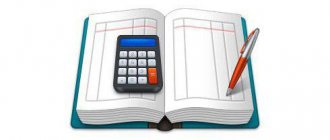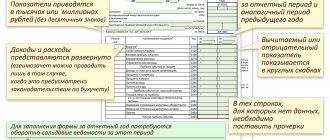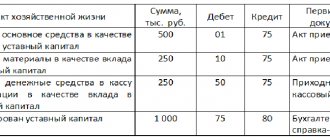The liability side of the balance sheet contains the sources of formation of property (assets), which are divided into equity and borrowed capital. Own capital is reflected in section III “Capital and reserves”.
Equity is the net value of property, defined as the difference between the value of the organization's assets (property) and its liabilities. Own capital may consist of authorized capital, additional and reserve capital, and retained earnings.
Balance sheet. Section III Capital and reserves
Assets
The balance sheet asset consists of 2 sections:
-1. Fixed assets.
-2. Current assets.
SECTION 1 Non-current assets
Article 1110 “Intangible assets”
We take the balance on account 04 (Intangible assets) minus the balance on account 05. (Amortization of intangible assets)
Formula=04 count -05 count.
Article 1150 “Fixed assets”
We take the balance on account 01 “Fixed assets” and minus account 02 “Depreciation of intangible assets”
Formula=01 account-02 account
Article 1170 “Financial investments”
We take the balance of account 58 (financial investments in terms of long-term financial investments) + 55/DEPOSIT + 73/1 (loans issued to employees) - account 59 (reserve for impairment of financial assets in terms of long-term financial investments).
Formula=58+55/Deposit+73/1- 59 account
Article 1190 “Other non-current assets”
Formula =Dt balance on account 08+Debit balance on account 07+Debit balance on account 97 for more than 12 months. There is a letter from the Ministry of Finance saying that advance payments to suppliers for the purchase of fixed assets are reflected in the line “other non-current assets”, some kind of nonsense, but I will introduce this nuance to you.
Article 1100 “Result under Section 1”
We summarize all asset items in section 1 “Non-current assets”
Section 2 Current assets.
Article 1210 “Reserves”
Formula = Account balance 10 (materials) + Account balance 41 (goods) + Account balance 43 (finished products) + Account balance 15 + Account balance 16 + Account balance 45 (Goods shipped) + Account balance 20 (main production) + account balance 44 (sales expenses) + Account balance 97 (deferred expenses) + 21,23,28,29-Account balance 14
Article 1220 “VAT”
Formula = Debit balance on account 19 “Value added tax”
Article 1230 “Receivables”
Formula = Dt 46+Dt60/02+Dt62/01+Dt76+Dt68+Dt71+Dt73/damage compensation+Dt75/For contributions to the authorized capital.-Credit balance on account 63 (reserve for doubtful debts)
Comments: under account 60/02 (advances issued), VAT is calculated on the prepayment, as well as under account 76. In accordance with PBU, if account 60/02 is the amount of 10,000 rubles and 60/01 is 5,000 rubles, then we do not find the balance on account 60 and do not record one total balance in the balance sheet, PBU does not allow this, i.e. 60/02 will be in accounts receivable 10,000 rubles and 60/01 - there will be 5000 rubles in accounts payable in liabilities. (i.e. we do not offset accounts receivable and payable). (On account 60 there will be an expanded balance dt balance 10000 Kt balance 5000)
76 each if there are advances issued, 68 if there are receivables.
ATTENTION:
-If you have a balance on account 76/AB (VAT on advances and prepayments received), then it must be deducted from the Accounts Receivable line. (Section 2)
-There is a letter from the Ministry of Finance stating that 60-02 for prepayments issued to suppliers for the purchase of fixed assets does not need to be included in the “Accounts receivable” line, but in “other non-current assets”; you decide what to do.
Article 1240 “Financial investments”
Formula = Account debit balance 58 (financial investments in terms of short-term) + 55/deposits (special accounts in banks in terms of short-term) = 73/Loans issued to employees (in terms of short-term)
Article 1250 “Cash”
Formula = 50 balance account (cash) + 51 balance account (current account) + 55 account (except deposits) + 57 (transfers in transit).
Article 1260 “Other current assets”
Formula = Account balance 94+76/VAT (VAT accrued upon shipment of goods when ownership of the goods is transferred in a special manner after payment until the revenue is determined)
Article Result for section 2 current assets
Let's summarize all the articles in section 2
BALANCE (Balance currency is another
name )
sum up the total of section 1 + Total of section 2
Own shares purchased from shareholders
Own shares purchased from shareholders - using this line, joint stock companies reflect the value of their shares purchased from shareholders for their subsequent resale or cancellation.
Business companies or partnerships may reflect on this line the shares of participants acquired by the company or partnership itself for transfer to other participants or third parties.
Own shares transferred to the company in the reporting year, for which the participant must be paid their actual value according to the financial statements for the reporting year, are taken into account in accounting at their nominal value.
PASSIVE
The Balance Passage consists of the following sections:
- Capital
- long term duties
- Short-term liabilities
SECTION 3 CAPITAL
Article 1310 “Authorized capital”
Formula = Account credit balance 80 Authorized capital"
Article 1320 “Own shares”
Formula Debit balance for account 81. (item is reflected in brackets)
Article 1340 “Revaluation of non-current assets”
Formula - We take the balance on account 83 in terms of the revaluation of intangible assets and fixed assets.
Article 1350 “Additional capital”
Formula = Take the balance of account 83, except for the revaluation of fixed and intangible assets
Article 1360 “Reserve capital”
Formula = Take the balance of account 82 “Reserve capital” credit.
Article 1370 “Retained earnings (uncovered loss)”
Formula = Take the balance on the credit account 99 (profit and loss, if the balance on the debit then put a minus in front of the amount) + Take the balance on the account 84 (Retained earnings, if the balance on the debit then put a minus in front of the amount). If the amount turns out to be a minus (loss), then write the amount in parentheses. And when we calculate the total for section 3, we subtract this amount.
Article 1300 “Total for Section 3”
Formula = Authorized capital - Own shares + Revaluation of non-current assets, additional capital + Reserve capital + Retained earnings (if in parentheses with a minus, then subtract)
SECTION 4 Long-term liabilities
Article 1410 “Borrowed funds”
Formula = Credit balance on account 67 “Long-term loans and borrowings” (in terms of more than 12 months of repayment)
Article 1430 “Evaluated liabilities”
Formula = Credit balance of account 96 “Reserves for future expenses” (in terms of more than 12 months from the reporting date)
Article 1450 “Other obligations”
Formula = Account balance 86 (targeted financing in terms of long-term ones) + 60,62,68,69 (in terms of repayments over 12 months).
TOTAL for section 4
Let's summarize all the articles in section 4.
Section III Capital and reserves
Authorized capital (share capital, authorized capital, contributions of partners)
Authorized capital (AC) is the amount of contributions of the founders to the initial development of the enterprise. The minimum amount of authorized capital is determined by law for each organizational and legal form. The maximum size is not limited and is determined by the founders of the company. The size of the charter capital must be fixed in the constituent documents, and any change in it must be registered with the tax authority.
The line “Authorized capital” always reflects the amount of the authorized capital registered in the constituent documents. It doesn’t matter whether the founders paid for it or not, their debt under the charter capital will be reflected separately in the balance sheet.
The first entry that an accountant makes in a newly opened company is a reflection of the amount of the authorized capital.
The authorized fund is the amount of funds allocated free of charge by the state for state and municipal organizations in order to ensure its activities. Unlike the authorized capital, the authorized capital is indivisible, its only owner is the state.
Let's look at how to make a balance sheet in 1C: Accounting
One of the main reports among a company’s financial statements is its balance sheet (balance sheet in 1C).
It shows the financial and property situation of the company at the reporting date in monetary terms. The balance sheet contains information about assets, liabilities and equity. The balance sheet refers to regulated reporting, that is, it is used both by the company itself and is generated for the regulatory authorities at the place of state registration of the organization: the tax inspectorate and the state statistics body.
Balance sheet
Drawing up an annual financial report is the final stage of the entire accounting process for an organization in a calendar year. To ensure the accuracy and completeness of the information included in the reporting forms, preliminary work is necessary, consisting of a thorough reconciliation of synthetic and analytical accounting data. In addition, at the end of the annual accounting cycle, it is necessary to make final annual entries, as well as calculate totals and account balances.
The balance sheet is one of the forms of financial statements, the procedure for preparation and presentation of which is approved by regulatory documents. It is a summary in tabular form of data on the value of property, as well as the obligations of the organization.
Using the balance sheet, you can evaluate the financial condition of the organization, find out what property it has, as well as how much debt it has.
Balance Sheet Structure
The balance sheet reflects the property, capital and liabilities of the organization in monetary terms as of a certain date.
The components of this document are:
- asset (reflects property by type and group);
- liability (reflects the organization's equity and liabilities).
Assets and liabilities must always be equal, which is why this form of reporting is called a balance sheet.
Assets
Includes 2 sections:
- non-current assets (these are assets used for more than one year: equipment, buildings, long-term investments, etc.);
- current assets (these are assets used for less than one year: raw materials, supplies, cash, etc.).
It is believed that current assets are more liquid than non-current assets. In other words, they can be converted into money faster.
Passive
Unlike the balance sheet asset, which shows what property the organization owns, the liability reveals the sources of formation of this property.
Includes 3 sections:
- capital and reserves (these are the own funds of the organization’s owners);
- long-term liabilities (these are loans, credits and other debt with a maturity of more than one year);
- short-term liabilities (this is current debt to suppliers, employees, etc. - debts that are payable within one year).
Why and who needs a balance sheet?
The balance sheet is the financial face of an organization. Thanks to it, those individuals who already have a relationship with the organization or are planning cooperation with it can assess the financial situation of this organization.
The balance sheet is studied by banks to assess the borrower's creditworthiness, and is also submitted to tax and statistical authorities. In addition, the document is presented to shareholders as a financial indicator of the work done by management.
Typically, the balance sheet is analyzed in conjunction with another form of financial reporting - the profit and loss statement. Thus, all the main ratios that characterize the financial “health” of the organization are identified.
Three possible states of the organization:
- neutral (no profit, but no loss);
- there is profit (accumulations within the organization);
- there is a loss (there are no funds to pay off the obligations of the organization).
Types of balances
There are different criteria by which balance sheets are divided, for example by: time (introductory, initial, interim, final, liquidation); completeness of information (general, specific). Opening. Such a document is drawn up in the event of the establishment of an organization, approval of a company, joint stock company, etc. Initial. This document is drawn up every year in order to clarify the property status of the organization after its annual work, as well as to determine the qualitative composition of the property. The opening balance drawn up at the end of the reporting year is final in relation to the past year and initial – in relation to the coming year. Intermediate. This type of balance, also called a test balance, is compiled quarterly, and at the end of the financial year it can be adjusted. Final. Such a document, also called a liquidation document, is drawn up in the event of termination of the organization’s activities. It is compiled by a special liquidation commission. General. Contains information about the property, rights, and obligations of the entire organization. Private. It includes information about the property, rights, and obligations of a separate part of the organization.
We are pleased to offer our accounting services, including balance sheet preparation services. Contact us!
Other operations for balance in 1C 8.2
In addition to the fact that a balance sheet can be generated and printed in the 1c program, other operations are also performed with it, for example:
- Reuse it. It will be located in the “1C - Reporting” section. You can open the section using the commands Reports - 1C-Reporting - Regulated reports. You can reopen the document and make changes to it if necessary;
Photo No. 11. Balance adjustment menu:
Balance adjustment menu
Check the report. You must select “Check” - “Check upload”. 1C shows existing errors for further correction;
- After correcting errors, the balance can be uploaded to any external media and sent to the Federal Tax Service.
In addition to the balance sheet, in 1C such operations can be done with other regulated reports. By left-clicking on the “Regulated Reports” sub-item, a window will open as shown below.
Here you need to select an organization, in this example - Trading House "Complex LLC" and the reporting period, in the example, the 1st quarter of 2021. Then click on the "Create" button - the "Types of reports" window will open; In the "Types of reports" window that opens, In the “All” tab, in the “By categories” section, select the “Accounting statements” item, to do this, click on “+”. A list of financial statements will appear on the screen. In this list, find the item “Accounting statements since 2011” and click on the “Select” button;







